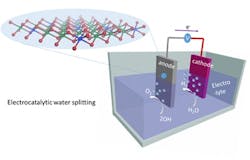Catalysts Could Boost Hydrogen Production
Independent of each other, research teams in Germany and Sweden have developed new catalysts that could challenge the need for precious metals currently used to produce hydrogen.
[pullquote]
The first team, at Ruhr Universitat Bochum (RUB), Bochum, Germany, says it discovered a catalyst that’s as efficient, but less costly, than the expensive platinum ones used in electrodes to catalyze the reaction of water to hydrogen and oxygen.
The team, headed by Ulf-Peter Apfel and Wolfgang Schuhmann of RUB and consisting of colleagues from the Max Planck Institute for Coal Research in Mülheim an der Ruhr and the Technical University of Bratislava, Slovakia, contend the solution is pentlandite.
Figure 1. Artificial pentlandite achieved “surprisingly high” results in hydrogen production. Source: Ruhr Universitat Bochum.
A nickel and iron sulfide mineral, pentlandite is the chief source of nickel today. According to the researchers, its structure resembles the active center of hydrogenases, which are hydrogen-producing enzymes found, for example, in green algae. In the current study, the researchers compared the hydrogen production rate of both naturally obtained and artificially produced pentlandite with platinum and other non-metallic catalysts.
Artificial pentlandite and platinum prove to be equally good catalysts, with a performance that surpasses that of other materials tested. The mineral synthesized in the lab produced hydrogen much more efficiently than the naturally found variant.
The reason for this, say the researchers, is the magnesium and silicon found in natural pentlandite reduce its conductivity. They described the output of artificial pentlandite as surprisingly high; the rate of synthesis also remained stable for a long time.
The mineral has another advantage compared to other non-precious-metal materials — a greater active surface area to which the reacting substances can dock. In non-precious-metal materials, this surface has to be created using complex methods, such as applying the catalyst to an electrode in the form of nanoparticles.
The RUB team also considered other substances that can catalyze the reaction of water to hydrogen and oxygen and that don’t contain any precious metals. Among such compounds are the metal chalcogenides. However, these non-metallic materials usually are distinctly poorer conductors of electrons and are thus inefficient catalysts, they say.
The work has attracted funding from three German organizations: the German Research Foundation, the largest independent research funding organization in the country; the Emmy Noether Program, which supports researchers in the early stages of their careers; and a Liebig Stipend from the country’s chemical industry fund.
Figure 2. Electrocatalytic water splitting is about to get less costly, thanks to research at KTH Royal Institute of Technology. Source: KTH.
Meanwhile, scientists at KTH Royal Institute of Technology in Stockholm, Sweden, say that they too have discovered that a new material composed of common earth-abundant elements could serve as a catalyst for water splitting. This, they stress, could help change the economics of large-scale hydrogen fuel production.
KTH professor Licheng Sun, who in 2012 reported developing molecular catalysts for water oxidation with an efficiency approaching that of natural photosynthesis, is leading the work.
Researcher Ke Fan says the new material is a mono-layered double hydroxide involving nickel and vanadium, which offers a state-of-art electrocatalyst for water oxidation.
The low-cost, highly efficient nickel-vanadium monolayer outperforms other electrocatalysts composed of non-precious materials, Fan says. It also is a competitive, cheap alternative to catalysts that rely on more-expensive, precious materials, such as iridium oxide or ruthenium oxide.
“This is the first time that vanadium has been used to dope nickel hydroxide to form a water oxidation catalyst, and it works very well — even beyond our expectations,” Fan notes. “No doubt this material can greatly expand the scope of non-precious-metal elements of electrocatalysts, and it opens new areas for water splitting.”
One possibility the discovery raises is large-scale production of hydrogen fuel using Sun’s original catalyst.
The material possesses a layered structure with monolayer nickel-vanadium oxygen polyhedron joined together with a thickness below one nanometer, says researcher Hong Chen.
“This monolayer feature not only increases the active surface area, but also enhances the electron transfer within the material,” Chen adds.
Sun expects the research to “open a new area of low-cost water oxidation catalysts, featuring stability and efficiencies that equal or even surpass some of today’s best catalysts.”



